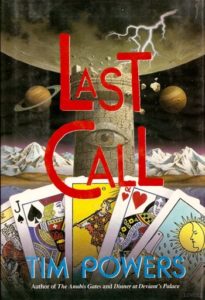 By TIM POWERS (William Morrow; 1992)
By TIM POWERS (William Morrow; 1992)
Here’s a novel that adequately displays both the strengths and weaknesses of Tim Powers’s unique brand of fantasy—or, as LAST CALL’S jacket description proclaims, “magical realism” (the novel hails from a period in which Powers’s publishers were attempting to rebrand him as an heir to Gabriel Garcia Marquez). On the plus side is the madcap imagination, paired with robust and authoritative prose that was and still is the author’s trademark. On the downside is a wildly overcomplicated narrative, contained in an overly-expansive superstructure that can barely contain itself within the novel’s 479 pages—which is, unfortunately, another Tim Powers trademark.
The set-up is actually fairly simple but, this being a Tim Powers novel, takes a hundred pages to sort itself out. It begins with Georges Leon, a shadowy figure who kills Benjamin “Bugsy” Siegel, the real-life mobster who founded Las Vegas and, in this novel’s world, is a supernaturally-endowed demi-God. Leon is Siegel’s rival, and desperate to take him down. Following the assassination Leon becomes a hunted figure, begetting a son named Scotty who he promptly loses.
The story picks up a few decades later, with Scotty, now a grown-up identified as Crane, haunted by the recent death of his wife Susan. Crane was raised by Oliver, a.k.a. Ozzie, a poker player who got Crane hooked on the game. This led to an epic game of poker called assumption that took place aboard a houseboat on Lake Mead in 1969, in which Crane won a ton of money. Apparently far more than money was assumed in that game, as both Ozzie and Crane’s foster sister Diana, with whom he’s in occasional psychic contact, disappeared after it ended. It seems Ozzie knows something Crane doesn’t, and now there are people connected with that fateful assumption game who are trying to kill Crane, and also Ozzie and Diana.
Beyond that I’m a little fuzzy on what-all happens. Powers at least keeps things lively, with body snatching, a one-of-a-kind tarot deck hidden in a Las Vegas basement, a lake dive in search of the submerged head of Bugsy Siegel, an attack by a bunch of giant statue-figures and a final game of assumption in which the fates of Crane and his cohorts are decided. There are also, of course, quite a few subsidiary characters thrown into the mix, many of whom are killed before the end.
So this novel is not without its charms. In fact, as a treatise on the occult underpinnings of poker, which is here directly linked to another “game” played with Tarot cards, it’s downright fascinating. It’s just too bad about the narrative, which requires a guidebook to properly follow.
